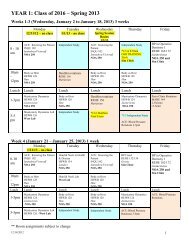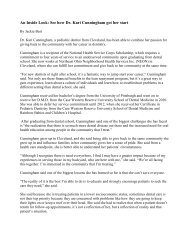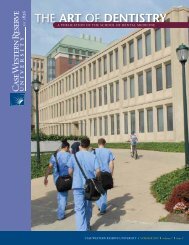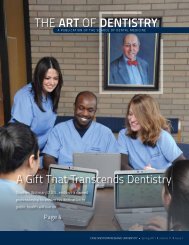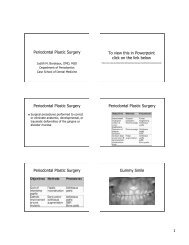Your generosity is important to us - School of Dental Medicine ...
Your generosity is important to us - School of Dental Medicine ...
Your generosity is important to us - School of Dental Medicine ...
You also want an ePaper? Increase the reach of your titles
YUMPU automatically turns print PDFs into web optimized ePapers that Google loves.
Public health program <strong>is</strong> one <strong>of</strong> only two in midwest<br />
the Case Western reserve University school <strong>of</strong> <strong>Dental</strong><br />
medicine <strong>is</strong> quickly becoming a center for dental public health<br />
training thanks <strong>to</strong> new academic programs spearheaded by<br />
Dr. sena narendran. the school <strong>is</strong> now <strong>of</strong>fering a dual-degree<br />
program in dental medicine and public health (DmD/mPH), a<br />
residency program, and a fellowship. these programs will be<br />
implemented within the next few months.<br />
each <strong>of</strong> the first two programs <strong>is</strong> funded for five years by the<br />
Health resources and services admin<strong>is</strong>tration (Hrsa), <strong>to</strong> the<br />
combined amount <strong>of</strong> nearly $2.6 million. the residency program<br />
will be the only Hrsa-funded program <strong>of</strong> its type in the United<br />
states for the next few years. Further, it will be one <strong>of</strong> only two<br />
dental public health training programs in the midwest.<br />
there <strong>is</strong> an immediate need for public health dent<strong>is</strong>ts. there were<br />
4,438 <strong>Dental</strong> Health Pr<strong>of</strong>essional shortage areas (DHPsa) in the<br />
United states as <strong>of</strong> February 2012. nearly 48 million people live in<br />
the DHPsas. the number <strong>of</strong> americans without dental insurance <strong>is</strong><br />
more than 130 million and about 17 million low-income children<br />
v<strong>is</strong>it the dent<strong>is</strong>t less <strong>of</strong>ten than once a year. among children aged<br />
two years <strong>of</strong> age and older only 45 percent had a dental v<strong>is</strong>it during<br />
a 12-month period. <strong>of</strong> the 60 DHPsas in the state <strong>of</strong> ohio, 10 <strong>of</strong><br />
them are located in Cuyahoga County. it <strong>is</strong> anticipated that most <strong>of</strong><br />
the CWrU-trained dental public health pr<strong>of</strong>essionals will choose <strong>to</strong><br />
work in the local or national<br />
underserved areas.<br />
the advanced education/residency<br />
program in dental public health at<br />
CWrU has three tracks <strong>to</strong> meet<br />
different candidate’s needs:<br />
• one year full-time,<br />
• two year part-time, and<br />
• two year full-time<br />
the first two tracks are for dent<strong>is</strong>ts with<br />
an accredited master’s degree in public<br />
health (mPH); the last track <strong>is</strong> for<br />
dent<strong>is</strong>ts without an mPH or equivalent<br />
degree. students in th<strong>is</strong> track will<br />
primarily be working <strong>to</strong>wards the<br />
accredited mPH program at the CWrU school <strong>of</strong> medicine during<br />
the first year <strong>of</strong> the residency program and will be primarily<br />
engaged in the dental public health residency activities at the<br />
school <strong>of</strong> <strong>Dental</strong> medicine during the second year. those<br />
successfully completing the advanced education/residency<br />
program will be educationally qualified <strong>to</strong> take the examination <strong>of</strong><br />
the american Board for <strong>Dental</strong> Public Health (aBDPH).<br />
About 17 million low-income<br />
children v<strong>is</strong>it the dent<strong>is</strong>t less<br />
<strong>of</strong>ten than once a year.<br />
Among children aged two<br />
years <strong>of</strong> age and older only<br />
45 percent had a dental v<strong>is</strong>it<br />
during a 12-month period.<br />
the length <strong>of</strong> the DmD/mPH dual degree curriculum <strong>is</strong> five years,<br />
one <strong>of</strong> which <strong>is</strong> dedicated <strong>to</strong> mPH courses. the mPH dedicated year<br />
can be taken before beginning the DmD program, between the first<br />
and second DmD years, or between the second and third DmD<br />
years. other options will be considered<br />
on a case-by-case bas<strong>is</strong>.<br />
the objectives <strong>of</strong> the 12-month dental<br />
public health fellowship program are <strong>to</strong><br />
provide didactic instruction in dental<br />
public health including research<br />
methods, opportunities <strong>to</strong> participate in<br />
oral health promotion activities in<br />
underserved areas, and extramural<br />
experiences at public health agencies.<br />
the Hrsa funding will provide eligible<br />
dental public health residents and<br />
DmD-mPH students financial support<br />
for tuition, stipend, and student health<br />
insurance during their public health<br />
training years. trainees will also receive travel funding <strong>to</strong> attend a<br />
national meeting and <strong>to</strong> extramural clinics for their public health<br />
practicum.<br />
For additional information about any <strong>of</strong> the dental public health<br />
training programs, please contact the direc<strong>to</strong>r, Dr. sena narendran<br />
(216.368.1311/sxn100@case.edu) or the program ass<strong>is</strong>tant, ms.<br />
Wendy Beins (216.368.6737/ wxb103@case.edu). n<br />
summer 2012 x 15



